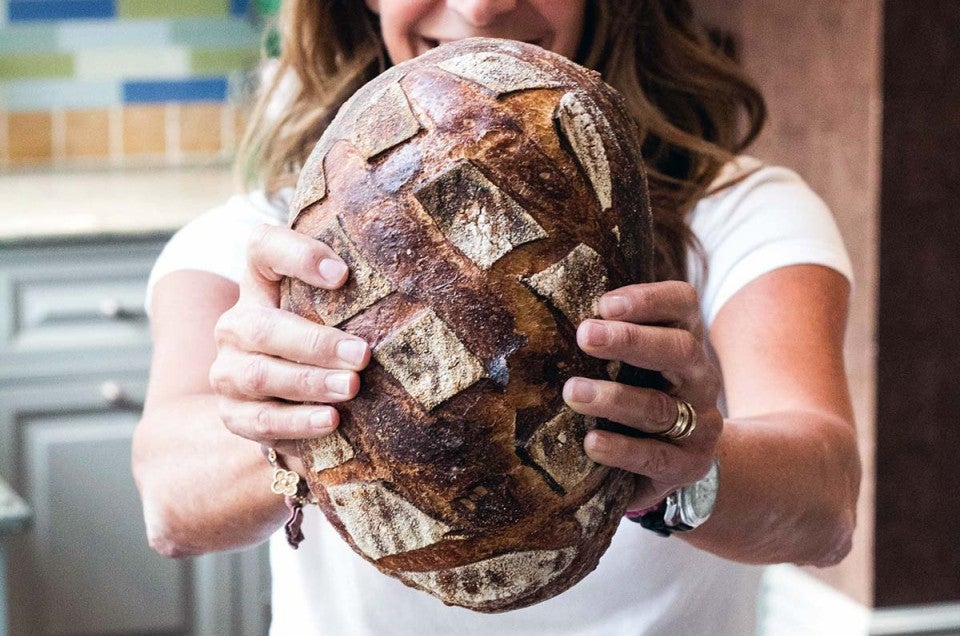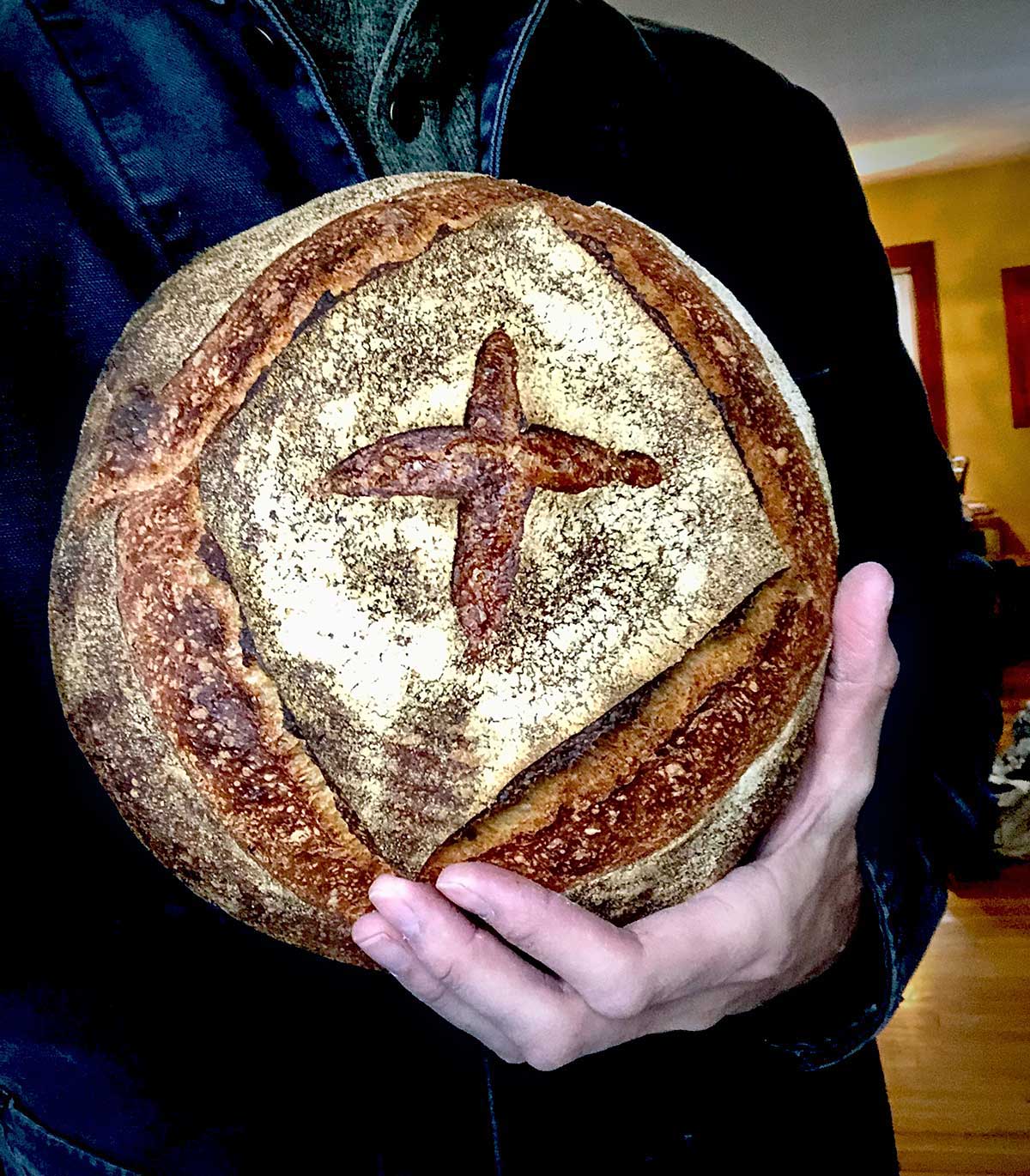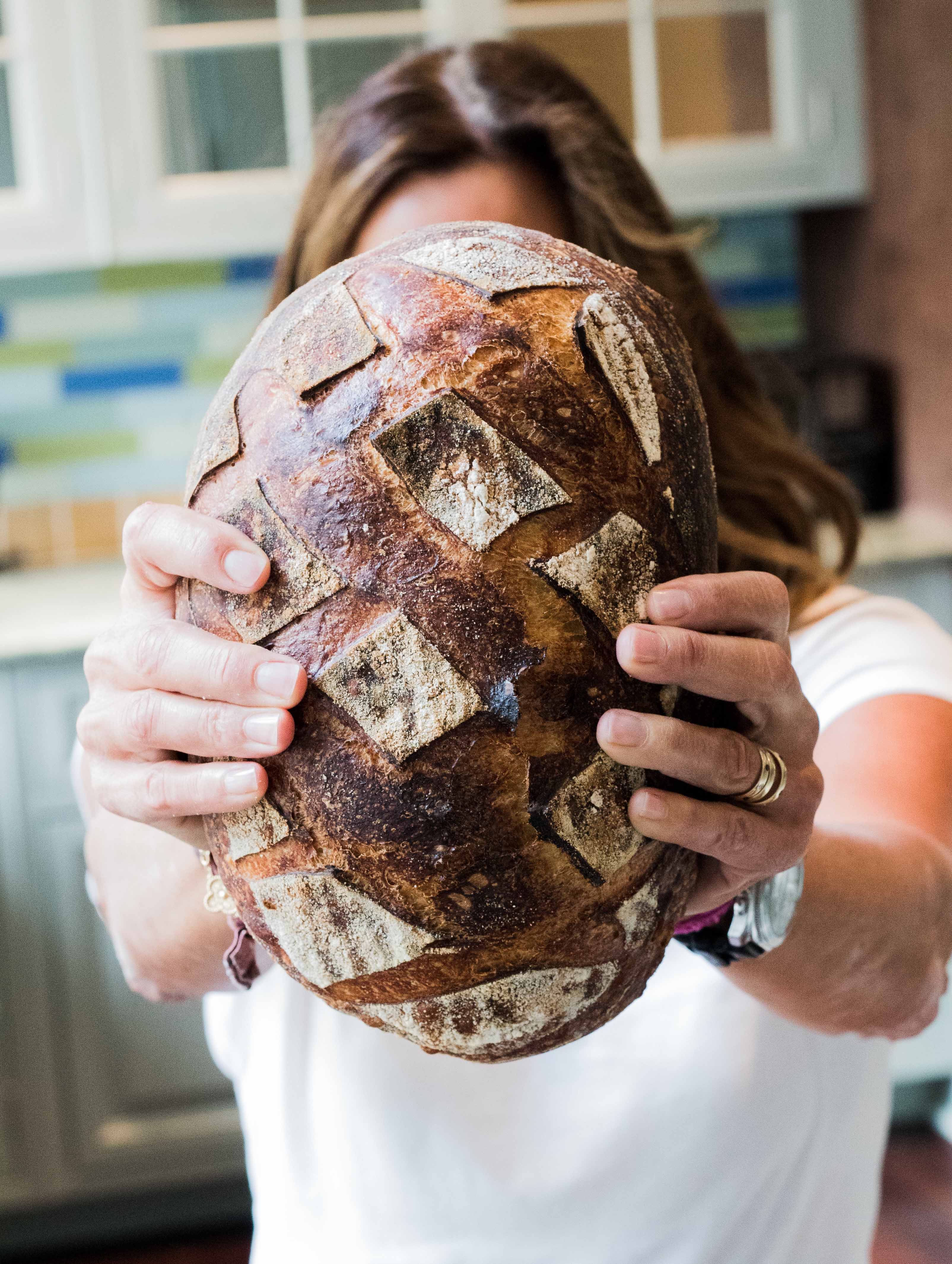


Bakers are friendly people. So friendly, in fact, that they ping my phone at all hours. Sometimes it’s a question (Hey! Where can I get those proofing baskets!?) or a picture of a great bake (Check this out!!! Jealous?) or a request for a recipe (Send me that Rye Pretzel pls). The conversation is open — you don’t need an intro — just let the random texts fly!
Recently, one of these exchanges changed the way that I make bread at home.
Maura: I’m not using preferments. I just use starter from the fridge ...
Me: No preferment??!
Maura: Nope
Me: How much bulk fermentation?
Maura: 12 hours ... it works ...
Me: ???? Send me a picture
Maura Brickman, a serious home baker in Connecticut, followed up her text with a picture of a large crusty loaf with gorgeous color. It was bakery quality by anyone’s standard — and she made it with "unrefreshed starter," straight from the refrigerator.

As a baker, convention has been my path to reliable results. I trust what I have done before — I know how to produce reliable results.
Maura doesn't care about convention. Free of “should” and “ought to,” she bends her breadmaking process to fit her busy schedule. She doesn’t take any guff from her starter or loaves — she's the boss of her bread.
After some thought about her method and convinced that there must be a flaw, I decided to give the Boss’ method a shot.
Before I outline her process, let me quickly clarify standard procedure: the way things normally go.
Sourdough bread traditionally begins with a preferment — a dough set for 12 to 18 hours to develop flavor — followed by mixing and bulk fermentation. After bulk, we divide, shape, proof (either at room temperature or chilled until the next day), and bake.
Maura alters this process to fit her day. Remember: She’s the boss! Rather than setting a preferment, she skips directly to the final mix, using a small amount of starter that she feeds once a week and keeps in the refrigerator to leaven her sourdough bread. After the mix, her dough rises for approximately 12 hours before the divide and shape.

If you've read the piece that I wrote about preferments and flavor, you’ll know that I think they're the difference between run of the mill and a loaf you’ll remember. In this method, which skips the preferment, flavor comes from the long bulk fermentation. We’ve got flavor covered — just in an unorthodox way.
But why not just go with the normal process? Here’s the answer.
Have you ever been a bread hostage? Did you ever feel like, “I’d love to make bread but I don’t have a half day to do so.” Or, “I’d love to attend your wedding, but I might be making bread that day.” At my house, there's quite a bit of coming and going. While I enjoy the opportunity to slow down and make beautiful things, there are also days where I just need to put great sourdough bread on the table.
As a professional baker, the needy schedule of bread and pastry can rule my day. But when I’m on my own time, it can be a challenge to fit everything in. Does this ring a bell?
Maura’s system offers several points of relief. First, it allows me to limit my dough interactions to the beginning or end of the day (no more “take your dough to work” scenarios).
Second, I don’t have to plan too far ahead if I want to mix up a dough (remember, no preferment, just grab some starter and go).
And last, there's no discard. I can thumb past all the delicious recipes for discarded starter, which (although amazing!) I may or may not have time to try.
Here’s Maura's process.

Maura usually starts after dinner, around 8 p.m. Like many serious bread bakers, she measures her ingredients exclusively by weight, so I’m going to do the same in this article. She also tracks the temperature of her ingredients. In this case, all dry ingredients should be room temperature, 70 to 72°F.
In a 6-quart container, combine the following:
900g King Arthur Unbleached Bread Flour
100g King Arthur Whole Wheat or Golden Whole Whole Wheat
800g tepid water (75°F to 80°F )
20g salt
40g sourdough starter, unfed/discard
Use starter straight from the fridge, though it’s best if fed within the past week.
Mix the ingredients by hand until the dough forms a shaggy mass and the flour is hydrated.
Set a 15-minute timer and leave the dough in the container at room temperature with the lid on.

At 15 minutes, return to the container and fold by pulling the sides of the dough up with a wet hand, then pressing to the middle to seal. Repeat this on all four sides, then set the timer again for 15 minutes.
Wait and fold the dough two more times. As you perform the folds you’ll notice that the dough smooths out, gaining strength and becoming elastic (more like a rubber band).
Leave the dough covered tightly at room temperature (approximately 72°F) overnight (about 12 hours). If using a mixing bowl, place the bowl in a plastic bag. If using a 6-quart container, just put the lid on — the main point here is that the dough should be well-covered to keep the exposed surface moist.

At 8 a.m. the next day (don’t be too uptight here — it could be 7 a.m. or 9 a.m.), divide the dough into two pieces. Gently form them into rounds, seam-side down, and rest for 10 minutes, covered.
Generously and evenly dust two lined bannetons with whole wheat flour.

Shape the loaves into boules or batards. If your dough doubled on the overnight rise (the marked 6-quart container will help with judging this), put the loaves straight into the refrigerator. If it's risen by just 50%, leave the loaves out for a bit (30 to 60 minutes) and then put them in the fridge. Note that the loaves should be covered with a shower cap or plastic bag.
Maura’s baking schedule (which is essentially a daily habit — no wonder she’s so good at it!) aligns well with her generous nature. Some days she bakes in the morning and distributes loaves to friends or neighbors. When her kids are home from college, she adjusts; they can easily polish off a loaf with dinner.
To bake, preheat two Dutch ovens — approximately 4-quart size — in a 500°F oven for 45 minutes. (Make sure your Dutch ovens are tough enough to be preheated empty; not all are. Check the manufacturer's literature.)
Invert the risen loaves onto a sheet of parchment, score with a lame, and carefully place the dough in the preheated Dutch ovens. Replace the lids and return to the oven.

Reduce the oven temperature to 450°F and bake for 20 minutes with the lids in place.
After 20 minutes, remove the lids and bake for another 20 to 25 minutes, or until the loaves have deep color.
After a few months of making Maura’s bread and receiving lots and lots of feedback from my family (often with a mouth full of bread), it’s become our daily loaf — the one that sits on our breadboard next to the butter. I’ve shared the process (via text) far and wide and have watched many people take on the role of Bread Boss.
As I’m an endless tinkerer and bread obsessed, I've adapted the recipe slightly. Here are some notes:
I use the same amount of flour (1,000g) but divide it differently. I use 750g of King Arthur Unbleached All-Purpose Flour. It’s strong enough for a good artisan loaf and it’s my Flour Power for the non-whole grain portion of just about everything in the house.
For the remaining 250g, I use a mixture of whatever flour I have on hand: whole wheat, golden whole wheat, whole rye, whole spelt, or even a little bit of buckwheat. I use a different blend of whole grains almost every time. My loaf is a little darker than Maura’s, but I love the flavor of the grains.

For water, I've lowered Maura’s quantity slightly. During cool months, I do need to warm my water to over 90°F; in warmer seasons, when my house isn't 60°F, I'll likely use 65°F water.
In early tests, my dough seemed a little sluggish. My Vermont wood-heated house is cool (many say cold!). As an adjustment, I increased the starter quantity to 100g in order to get things moving with a little more energy. As our seasons change and my house warms up I'll probably decrease the amount to Maura’s original 40g of unfed/discard starter.
Here are my measurements; all process steps remain the same.
750g King Arthur Unbleached All-Purpose Flour
250g King Arthur Golden Whole Wheat Flour
750g water — warm in the winter (90°F), cool in the summer (65°F), depending on ambient conditions
20g salt
100g sourdough starter

If you decide to give Maura’s bread a shot (every home needs a Bread Boss), let me know how it goes. Once you get the basic process down, you might consider adding seeds, toasted nuts, dried fruit, or even olives and herbs. As a starting point, for 1,000g of total flour use 200g of additions (in baker’s percentages that’s 20%). Keep all other measurements (water, salt, starter) unchanged.
As a general rule, anything dry (especially cracked or flaked grains, seeds, or toasted nuts) should be soaked in an equal weight of warm water for at least an hour — or even overnight — and strained before use. Olives and herbs don’t require this treatment as they're already moist. Use your imagination — maybe even dried figs with anise seed!
I want to express my gratitude to Maura for sharing her recipe and process. Baking is truly an act of love. When making things for our families, friends, and community, we bring our best selves. Thank you for the love!
For another recipe that uses the unrefreshed starter method, try our Do-Nothing Sourdough Bread recipe.


February 10, 2024 at 11:47am
In reply to I LOVE this recipe, I… by Carol (not verified)
Hi Carol, when increasing the starter amount to 100g, you can keep all the other weight measurements the same. For making hamburger buns with this recipe, I would recommend dividing the buns after the overnight bulk-ferment. Since this dough is not enriched, you may want to follow the steps outlined in our Ciabatta Roll recipe with this dough, yielding a more artisan-style hamburger bun. The timing of the rise after shaping may be a bit different than the linked recipe indicates, so let your dough be your guide.
January 30, 2024 at 2:08pm
My dough did not double this morning before work, so I put it in the refrigerator to halt it rather than leaving it on my counter all day while I was at work...newbie here, so what can I do to save it or am I doomed?
February 8, 2024 at 2:16pm
In reply to My dough did not double this… by Angela T Clodfelter (not verified)
Hi Angela! Putting the dough in the fridge to buy a bit more time is just fine to do! When you get back, you can take the dough out of the fridge to continue the rising process again at room temperature. How much longer you'll need is hard to say since we are not sure how much the dough has risen in the fridge, but just keep an eye on it! As soon as it reaches the right height, you can continue on with the recipe as instructed. Happy Baking!
January 21, 2024 at 8:57pm
Alright, I have read all the comments and can only assume that my starter is to blame. I have tried this recipe three times and the first time, they needed up a little flat so I figured maybe I needed to add some more starter so I tried again and added 65g of starter vs the 40g called for. At 12 hours, I had little to no rise so I placed it my oven and used the proof setting to help give it a boost. At 80 degrees Fahrenheit I figured a few hours should be enough. However after 5 hours I only had about a half inch over the original amount of dough with lots of big bubbles on top. So I figured I would shape and finish in the fridge but when I opened the container it was a sticky soup, couldn’t hold any shape and was very pungent. So I guessed it over fermented even though it never actually really rose. I dumped it and tried again with the same effect. My starter is fairly new but is rising consistently, I feed it every 12 hours and it has never been in the fridge. I’m lost. Help!
January 29, 2024 at 4:37pm
In reply to Alright, I have read all the… by Matt (not verified)
Hi Matt, did you use our Bread Flour for this recipe? If you happened to substitute another brand of bread flour or used our Unbleached All-Purpose Flour, this could have contributed to your difficulties. Room temperature also plays a very important part in the proper fermentation of this dough, so if your home happens to be much cooler than the 72°F recommended, this might explain the initial lack of rise. It's promising that the dough started to rise once you put it in a warmer environment, but this is where the lower protein flour might have come into play; a lower protein flour won't absorb as much liquid and could definitely contribute to a wetter, stickier dough. Is your starter doubling consistently within about 6-8 hours after you feed it? Some starters begin a bit more sluggishly than that, so it's helpful to see at least that activity level before attempting a recipe like this. For more help troubleshooting this recipe, please don't hesitate to call our Baker's Hotline. We're here M-F from 9am-9pm EST, and Saturday and Sunday from 9am-5pm EST, and the number to call is 855-371-BAKE (2253).
June 24, 2024 at 12:34pm
In reply to Hi Matt, did you use our… by balpern
Hi, both the original recipe and Martins video specifies KA Bread Flour, but the adjusted recipe in the blog shows AP flour. Is that right?
June 24, 2024 at 1:46pm
In reply to Hi, both the original recipe… by Richard Jabara (not verified)
Hi Richard, you're correct that Martin's version of this recipe (which appears in this blog post) does call for our Unbleached All-Purpose flour. Both our Bread flour and AP flour are good choices for making artisan breads, but notice also that the hydration is reduced to 75% when Martin changes the type of flour used. This is because the higher protein Bread flour will soak up more liquid than AP flour. Maura's recipe for Pain de Campagne has become the standard recipe featured in our videos and subsequent blogs, and this recipe does call for Bread flour.
January 13, 2024 at 5:00pm
I haven't tried this recipe/technique, so I can't say it wouldn't work for me. However, when I do the calculation for the percentage of starter (40 grams/1000 grams of flour) I come up with .04 or 4% starter. Most sourdough recipes use about 20% starter. Does this method work because of the very long bulk ferment (12 hrs at room temp)? Or could this very small percentage of starter be the reason several commenters found that their dough wasn't rising as much as it should? Thanks!
January 21, 2024 at 10:35am
In reply to I haven't tried this recipe… by Laurie Raz-Astrakhan (not verified)
Hi Laurie. Great question! Martin actually speaks to the amount of starter being used...I'll post that here: "In early tests, my dough seemed a little sluggish. My Vermont wood-heated house is cool (many say cold!). As an adjustment, I increased the starter quantity to 100g in order to get things moving with a little more energy. As our seasons change and my house warms up I'll probably decrease the amount to Maura’s original 40g of unfed/discard starter." It's ok to be fluid with the amount of starter being used. Because of the long fermentation time, that smaller percentage of sourdough can work well for many bakers. But, every kitchen condition (along with the activity level of every starter) is different, so once you find the ratio that works best for you, stick with it! Happy Baking
February 9, 2024 at 9:05am
In reply to Hi Laurie. Great question!… by rsalerno
this is similar to the method I have been using for years, using the classic NYT/Sullivan Street bakery recipe which calls for 290 g of flour and 85 g of starter for one loaf. I can't imagine using so much less starter. Also, if there's no discard, what is the feeding method? Just replace what you've used? I haven't had much success with that because it seems like that's not enough to feed the remaining starter. I feel like I waste a lot of starter since I discard most of the remaining starter when I feed otherwise it doesn't seem as lively.
Pagination